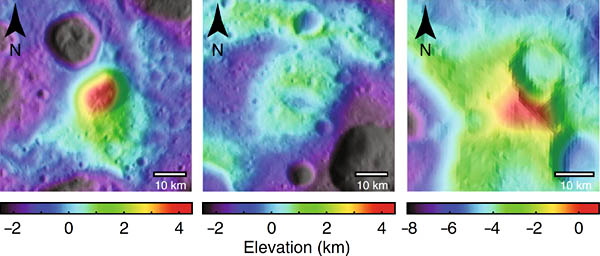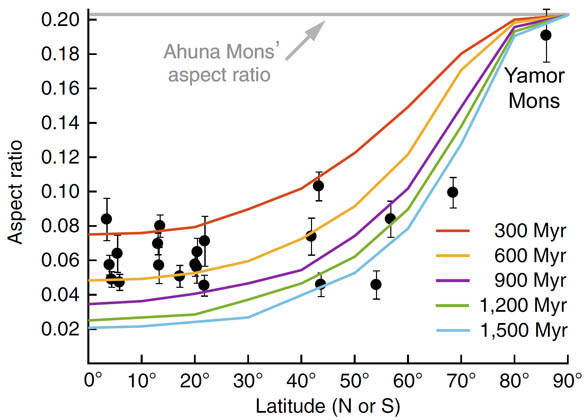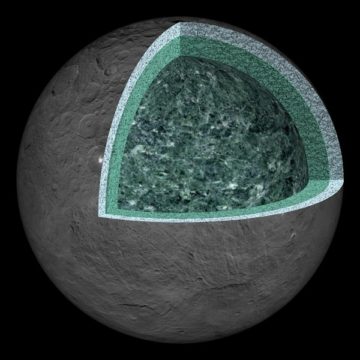A recent study explores the history and extent of cryovolcanism in the past — and likely present — on the giant asteroid Ceres.

NASA / JPL / UCLA / MPS / DLR / IDA / PSI
NASA's Dawn mission has opened up the brave new world of 1 Ceres, our solar system's largest asteroid. Now a recent study, published today in Nature Astronomy, has revealed something of the fascinating history of cryovolcanic activity on this dwarf planet, leading up to the surface we see today.
Cryovolcanism involves eruptions of slurries of water mixed with some kind of "antifreeze" — perhaps liquid ammonia (NH3) or methane (CH4) — at temperatures far below water's usual freezing point. The resulting flows are the supercold equivalents of the familiar rock magma involved in volcanic activity here on Earth.
Because Ceres is believed to harbor a deep, briny mix of fluid and solids beneath a rigid crust, geologists expect to find evidence of cryovolcanism on its surface. The large, isolated mound called Ahuna Mons is a fine example. The big question, though, is why Ceres isn't dotted with many more of these icy piles.
The key appears to lie in the subtleties of rheology, the physics of how material (in this case, ice) flows over time in response to gravity. The study used a combination of flow modeling coupled with topographic analysis to piece together the cryovolcanic history of Ceres.
Domes, Mons, and Tholi
Led by Michael Sori (University of Arizona), researchers carefully analyzed the appearance of 22 domes on Ceres, their aspect ratios (that is, how wide they are versus how high they rise above the surrounding plain), and their distribution by latitude. For the purposes of the study, tholi (the IAU-approved moniker for smaller, eruptive domes) and montes (larger mountains) were grouped together generically as "domes".

Michael Mori et al / Nature Astronomy
The team used the unique feature called Ahuna Mons as their reference standard. It towers 2.4 miles (4 km) above the surrounding landscape, and (based on the paucity of impact craters nearby) it appears to be no older than 240 million years — and it could be much younger. Ahuna Mons has a relatively high aspect ratio of near 0.2 (its base is five times wider than its height).

Michael Mori et al / Nature Astronomy
Then Sori and his colleagues estimated the age of 21 domes (all at least 10 km across) by assuming that they started out as tall piles of cryovolcanic material, much like Ahuna Mons, that slumped into shorter, broader mounds at a predictable rate over time. (The technical term for this is viscous relaxation.) The resulting age estimates range from hundreds of millions to 2 billion years old.
The study also found that the higher a dome's latitude on Ceres, the higher its aspect ratio. For example, domes near the equator of Ceres have low aspect ratios of around 0.06, while a large dome named Yamor Mons (at 85½° north) nearly matches Ahuna's 0.2 aspect ratio. Since the poles of Ceres are much colder, the rate of slumping there should be glacially slow.
How Much, and How Often?
Mori and his team used the global distribution of the domes and their estimated ages to deduce how often cryogenic activity should occur on Ceres. They deduced that an eruption might happen once per 50,000 years on average. Over time, these eruptions could disgorge about 10,000 cubic meters of briny slush onto the surface per year. That's equivalent to the volume of a large movie theater or four Olympic-size swimming pools — but it's a tiny fraction of the rate here on Earth, whose volcanoes spew more than 1 billion cubic meters of molten rock each year.
“We're excited that we were able to come up with a cryovolcanic rate to compare with the rates of 'regular' volcanism on terrestrial planets, something that hadn't been done before from observations,” Sori told Sky & Telescope.
What powers cryovolcanism on Ceres? Shouldn't such a small body have cooled internally by now? The most likely internal source powering cryovolcanic processes on Ceres is radioactive decay of certain isotopes in the rocky parts of the tiny world, as happens on other planets. Another, more controversial hypothesis is that large impacts on the surface of Ceres jump-start the process locally.
One of the first fascinating features Dawn spotted on its initial approach to Ceres were bright patches of fresh ice, known as faculae. (It's the same term used to describe bright patches on the photosphere of the Sun.) These spots, found on the flanks of Ahuna Mons and on the floor of the crater Occcator, were the first clue for researchers that cryovolcanism is still active on Ceres.

NASA /JPL / UCLA / MPS / DLR / IDA
Cryovolcanism might also be a key resurfacing mechanism on other rocky worlds in the outer solar system. In addition to Ceres, we see the action of ice geysers and ice floes on the surfaces of Saturn's moon Enceladus, the dwarf planet Pluto and Jupiter's moon Europa.
“We've shown Ceres may have been cryovolcanically active throughout its entire history, and there's no need to try to invoke a weird thermal/volcanic history that would have caused only a single cryovolcano (Ahuna Mons) to form very recently, with no volcanism before that,” says Sori. “Cryovolcanism is important on Ceres, but not nearly as dominant or important as rocky volcanism has been on Earth or Mars.”
Unfortunately, the end is near for the Dawn mission. Engineers estimate that the fuel for the craft's engine should run out sometime from late September to mid-October, after which Dawn will remain permanently in orbit around Ceres. Launched on September 27, 2007, atop a Delta II rocket, Dawn flew past Mars in 2009, visited asteroid 4 Vesta from 2011 to 2012, and explored Ceres starting in 2015.
Enjoy these final views of a cryovolcanic world, the only one we've sent a spacecraft to orbit thus far. Dawn should give planetary scientists plenty of data to pore over for years to come.
 0
0









Comments
You must be logged in to post a comment.